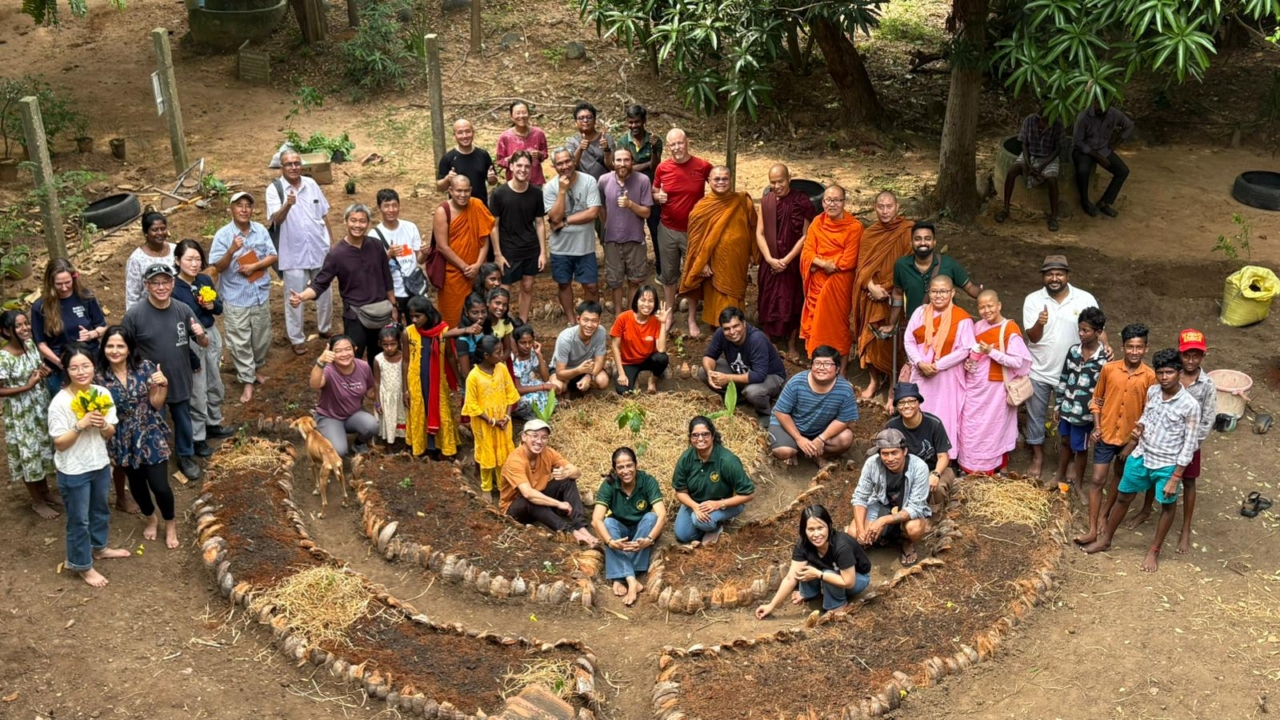An Eco-Temple Workshop Report

Hey there, heads up that this is a longer post than usual! Take your time with the photos, videos and links – let me know your thoughts and if these deeper dives tickle your fancy. I respect your attention so for the TLDR (Too Long Didn’t Read) check out the recap video produced by Linus Dolfini at the end – if you enjoyed, maybe send to a friend 🙂
India at last!
I’d heard much about this experimental city from alternative friends wearing hemp clothes but had held back on making too many assumptions ahead of time.
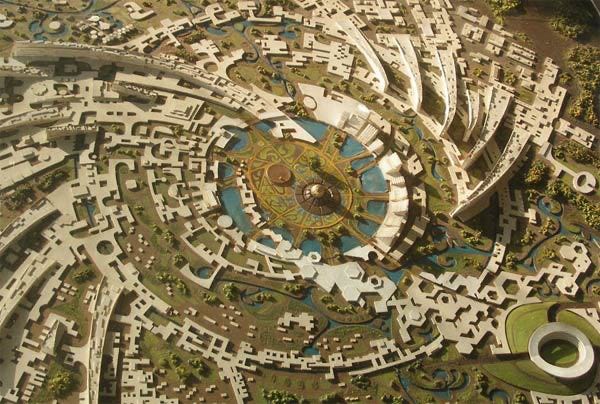
I knew it was the biggest eco-village on Planet Earth, that it had a glistening golden dome at its center, and that it was the vision of the one they call Mother.
While these factoids were enough to perk up my whiskers, it was ultimately thanks to the great and powerful Eco-temple Community Development Initiative that I made it to the rich soils of South India.
One direction in a vibrant mandala radiating out from the International Network of Engaged Buddhists (INEB), the Eco-temple Community organized a four-day hands-on workshop at Auroville as a build-up prior to INEB’s 21st Biennial Conference in Chennai.
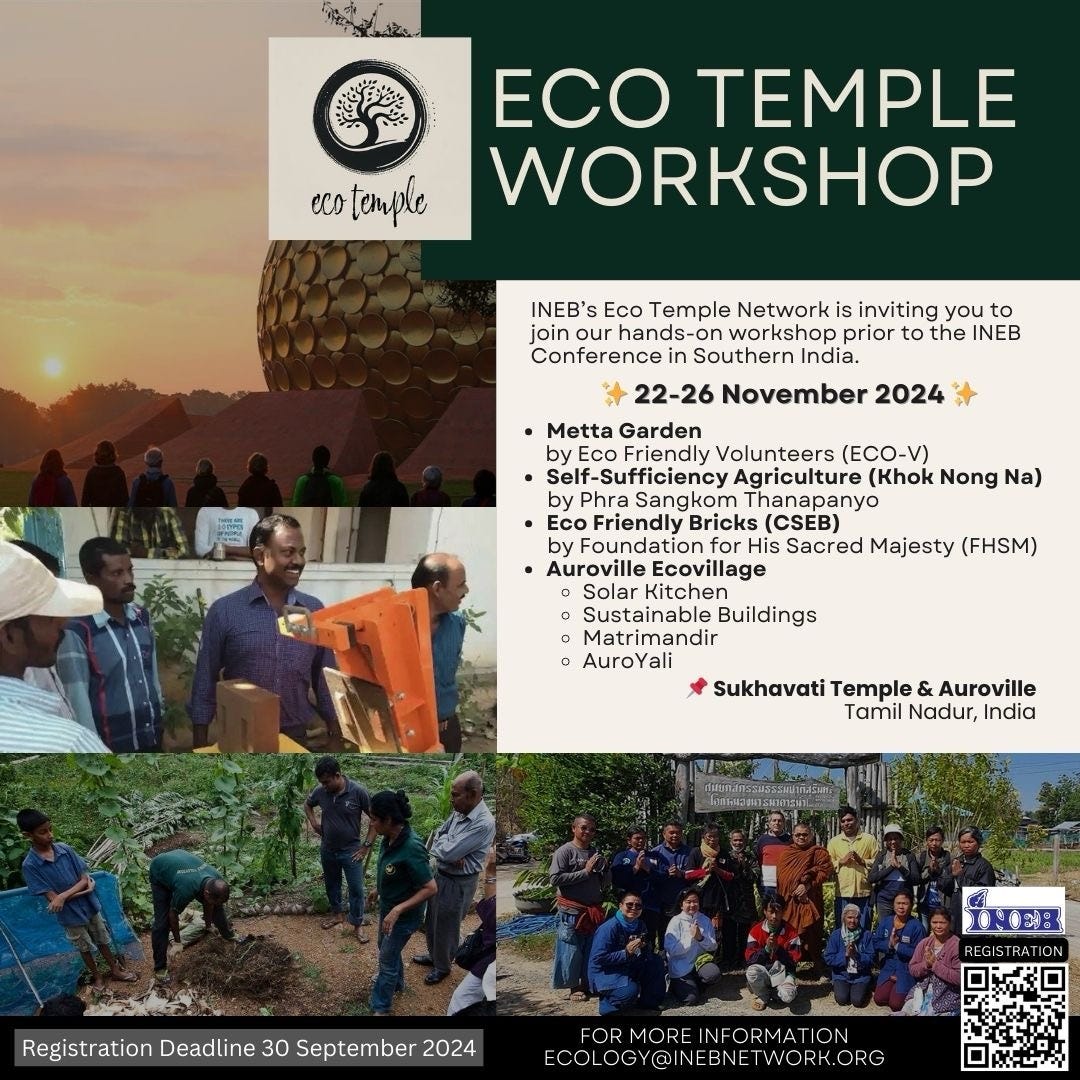
Based on the Kalachakra mandala, the Tibet Pavillion is an elegant and imposing example of eco-construction built mostly out of Compressed Stabilized Earth Blocks (CSEB), a technology developed by Auroville’s own Earth Insitute.
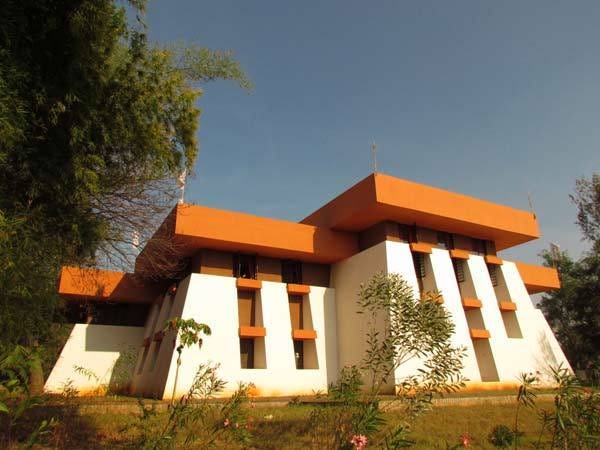
Within its thick walls, our motley crew of monks, nuns, and eco-folk were quick to sleep looking forward to a day free from mortal peril.
Cooing mynah birds rang in the dawn as we broke our fast on hearty multi-grain bread and sweet bananas. From the Tibet Pavillion, we rode a pleasant stretch of road through rural plains to the quiet site of a secondary school in the village of Nadukuppam.
Metta Gardening
A joyful horticultural practice that Kanchana developed in Sri Lanka by blending elements of permaculture design with Buddhist practice, Metta Gardens transforms small plots of land into living mandalas brimming with flowers, herbs, vegetables, and fruits.
Our Metta Garden was about 10 square meters but Lhundup Dukpa, the founder of Bhutan Soul Farmers, shared with me that he intends to build one in Bhutan that is at least 1 hectacre square!
A reciprocal practice for cultivating life with all seen and unseen beings, Metta Gardens offer those creating and maintaining them a space to engage loving kindness (pali. metta) in the world through embodied ecology. One can choose how deep they wish to go, from consciously aligning the garden with cycles of the sun to curating specific quadrants with colourful symbolic flowers and ayervedic plants.
Nearly forty mindful gardeners made quick work of the layout, planting and natural fertilization of the soil. Though we had got the ball rolling, it was the eager young students of the local school that would tend to this garden and bring its fruits to bear.
Their happy participation in our workshop grounded the entire affair in a sense of service, community development with the saplings of that community.
With seeds in the earth, our Respected members of the Sangha brought us full circle with a closing chant in pali beaming loving kindness into the surrounding soil, air, water, fire, and space.
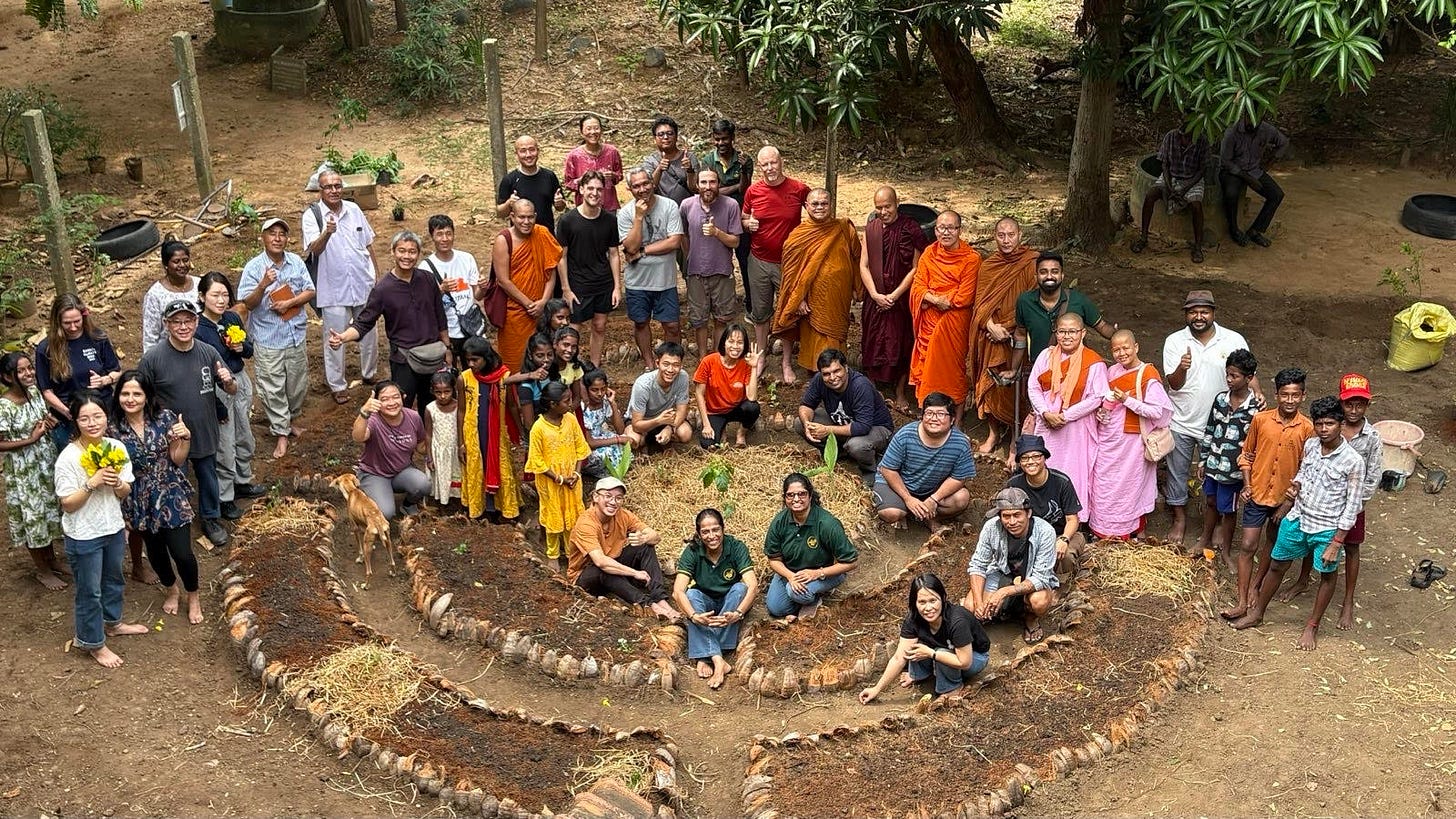
Kok Nong Nha
After a South Indian lunch of chai and dosa we sat in the open air next our freshly planted garden for an introduction to Kok Nong Nha, an innovative approach to land and water management wholeheartedly promoted by Thailand’s dearly departed King Rama 9.
The Dynamic Duo of Venerable Dr. Sangkom and Rajesh from Chonburi, Thailand made an impact with their presentation of the theory behind this increasingly popular ‘Sufficiency Economy’ practice amongst rural farmers.
Sharing examples from twelve years of work regenerating barren rice paddies in the Isaan region of Northeast Thailand, Dr. Phra Sangkom’s advocacy has garnered royal patronage which he has wisely directed into the establishment of an inspiring ‘Smart Pagoda’ utilized as a national training and development center from the promotion of the Sufficiency Economy.
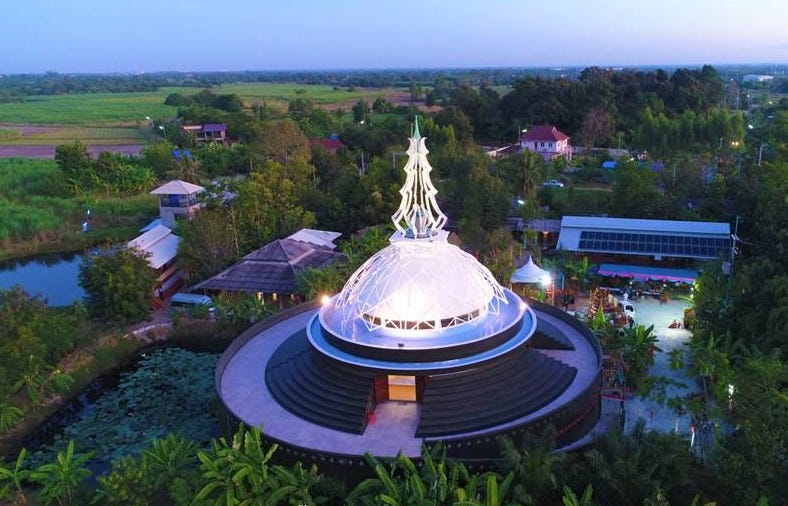
There was a real air of Sangha to the afternoon session as we listened intently to the enthusiastic Thai monk and his hearty disciple share their passion for unshackling mono-cropped minds.
More than once they remarked that we must not be slaves to corporations set on extracting meager value from chemically fertilized land.
Gazing off into the trees I wondered how corporations have chemically fertilized our cultures too, extracting value from a small set of professional competencies while the rest of our dynamic human potential is only permitted expression on the weekends – or left to languish forever.
Some dozed in the shade while others laughed along as Dr. Phra Sangkom gave his “Very goooood” trademark approval for the micro experiment in Kok Nong Nha we were to run the following day.

Returning to the site after a restful evening in the Tibet Pavillion, we quickly got stuck into carving out the heart-shaped design of the Kok Nong Nha irrigation canals.
In about 10 minutes our group went from a crowd of content visitors to a Buddhist chain gang tilling thick soil with hand trowels and shovels. After forty minutes of dripping sweat and enjoyable physicality, we began to see the Ajahn’s vision take form.
The Kok Nong Nha methodology guides farmers to allocate 1/3 of their land for deep ponds and canals, 1/3 for elevated intercropped forestation with fruit and other trees, and 1/3 for rice cultivation and habitation. This approach moves farmers closer to self-sufficiency ensuring that a range of food can be grown year-round with ample water supply for rice and daily living.
Tracing a heart in the earth, our micro experiment built up raised mounds (Thai. Kok) out of the soil excavated from the small pools and ditches (Thai. Nong). Space on the edges of the plot could be used for rice (Thai. Na) but we planted bananas instead.
Like any agricultural endeavor, it takes years to see the benefit of one’s work but the Kok Nong Nha approach was nothing new to the villagers of Nadukuppam.
Twenty years earlier large ponds had been dug with the support of the Auroville community to recharge the groundwater in the surrounding fields that had been clear-cut and were frequently bone dry. Though not explicitly part of an integrated farming system like Kok Nong Nha, this intervention had worked wonders on the local environment with cool forest now surrounding the school and village vicinity.
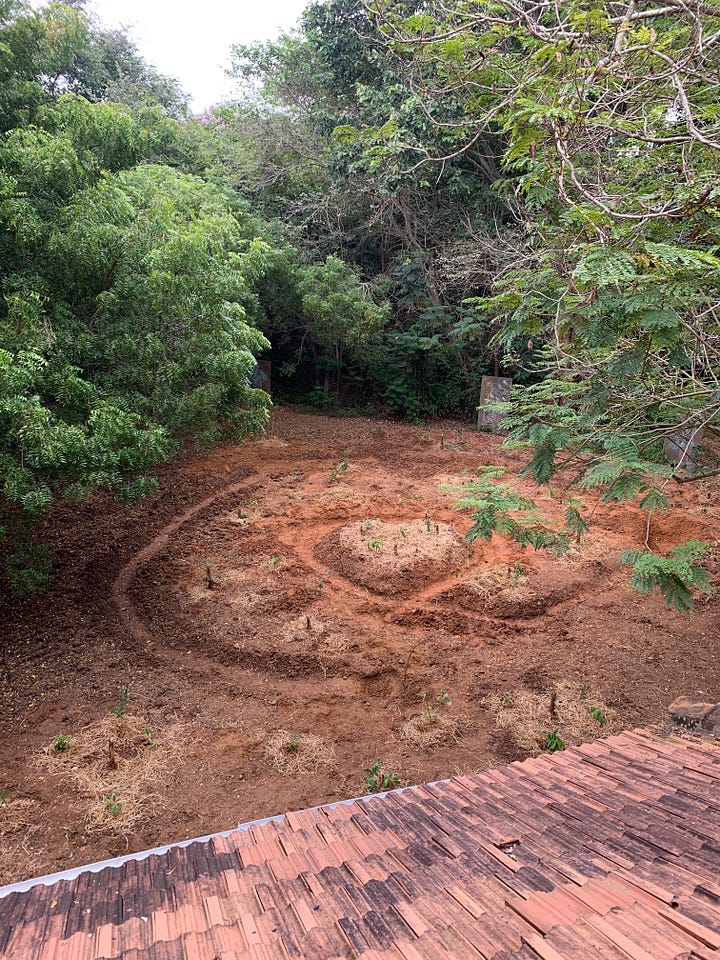
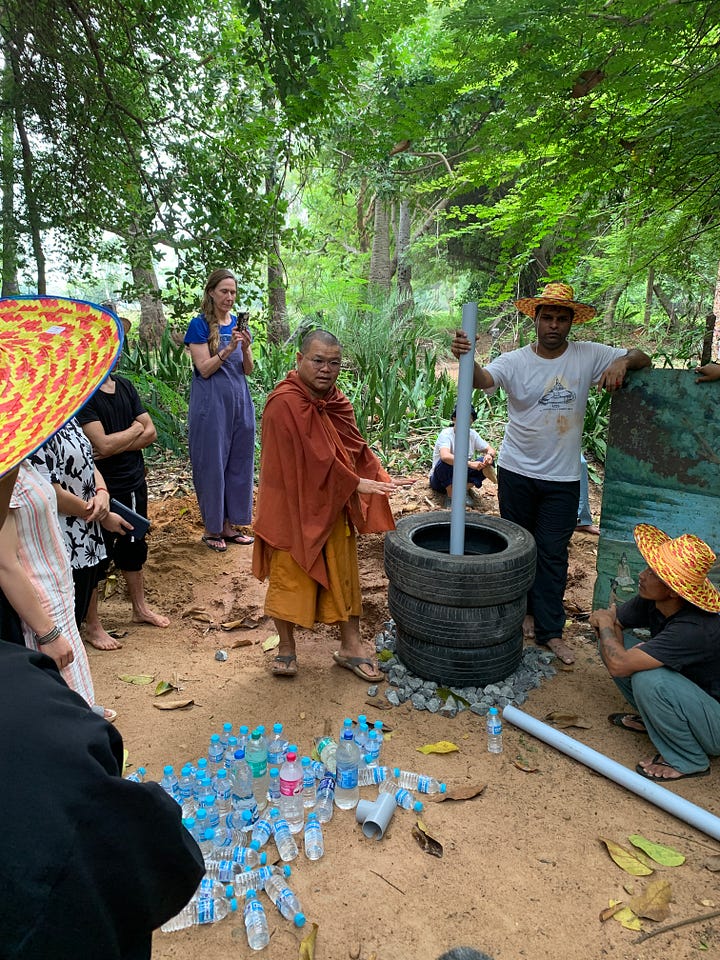
In a final blessing of exuberance, Dr. Phra Sangkom demonstrated the process of building a groundwater bank by placing car tires in a round excavated pit. By nestling the tires in place with gravel and inserting a PVC pipe through the center for airflow, the bank provides a channel for surface water from rains or floods to quickly penetrate deeper layers of sediment. This technique ensures that the water table remains full for the dry season nourishing the soil from the depths when rain is not falling.
Fulfilled by two days of truly hands-on learning our merry gang of earthlings thanked theNadukuppam School and villagers for welcoming us and returned to Auroville.
The City the World Needs
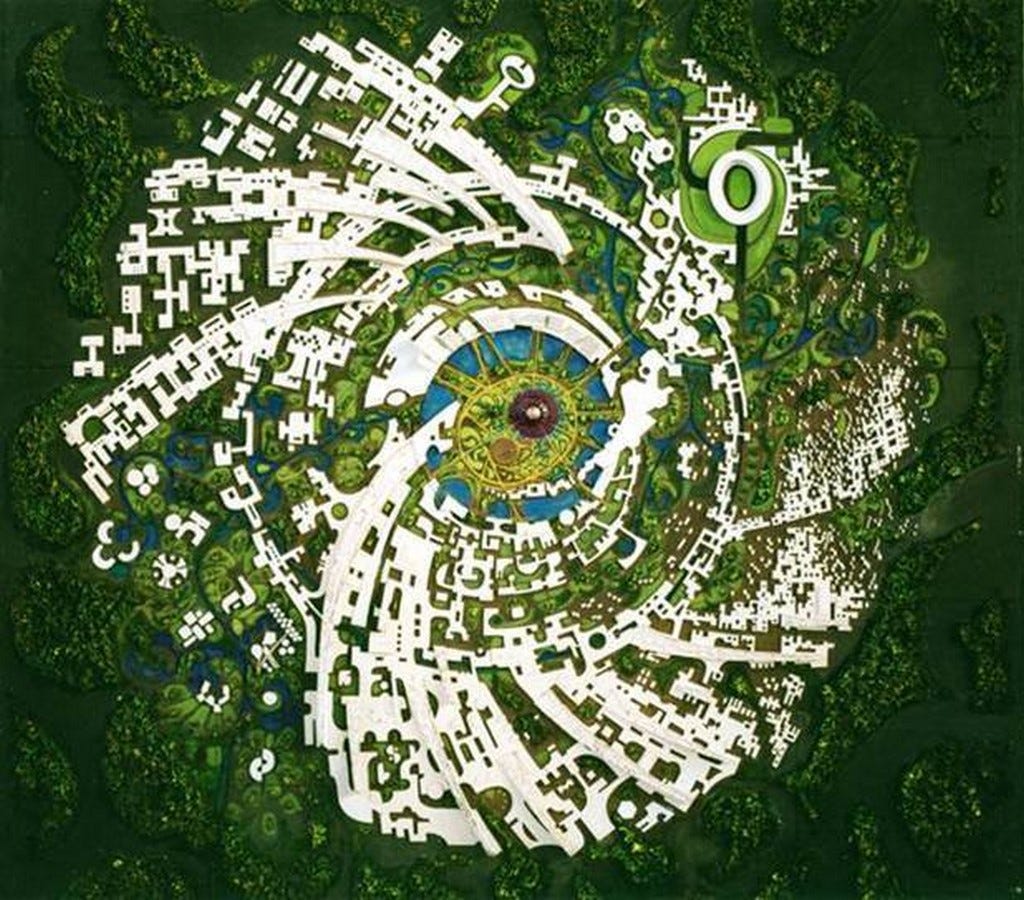
In 1968 French avant-garde architect Roger Anger presented the ‘Galaxy Plan’ to the Mother (born Mirra Alfassa), the spiritual figurehead of the nascent city of Auroville. Inspired by the teachings of Sri Aurobindu, a modern Indian saint residing in the nearby city of Pondicherry, the Mother had a vision…
“Auroville wants to be a universal town where men and women of all countries are able to live in peace and progressive harmony above all creeds, all politics and all nationalities. The purpose of Auroville is to realise human unity.”
54 years later, Auroville has evolved from a 27 square kilometer desertified parcel of land into a regenerated forest biosphere with over 3,000,000 planted trees and 3,000 ‘Aurovillian’ inhabitants. Though the community has been somewhat embroiled in recent turmoil due to unscrupulous tree-felling and internal politics – what commune exists without controversy?
Driving from Nadukuppam Village we made a beeline for the center of the Galaxy where carefully manicured ‘Peace’ lawns frame an otherworldly Temple to Concentration known as the Matrimandir.
A wild architectural achievement, the golden golfball-like sphere contains an inner sanctum that only ‘serious and sincere practitioners of concentration’ are allowed to enter. For a city founded on the principle of unity and inclusion, one must apparently gather some chutzpah to experience the jewel at its center.
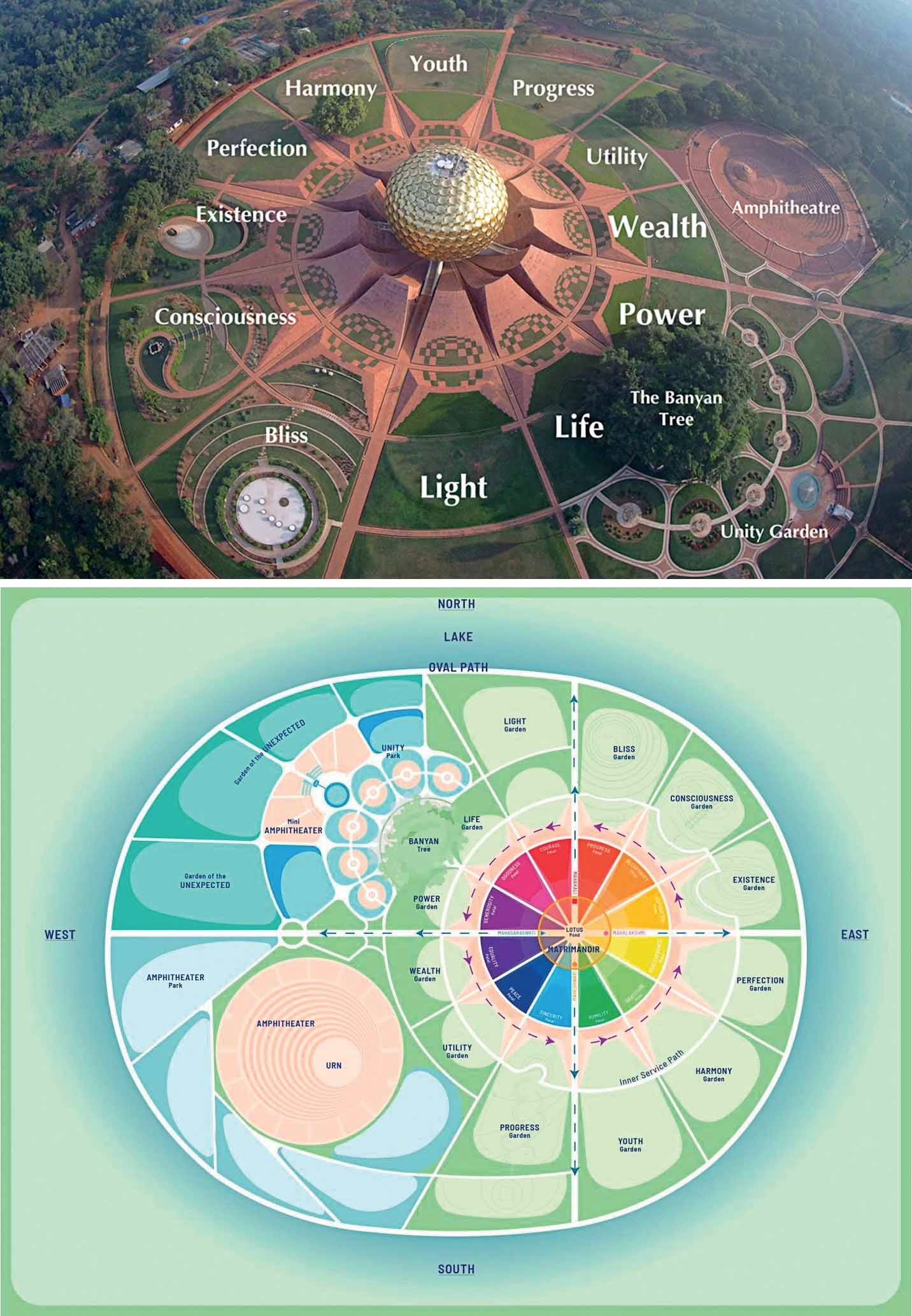
After viewing a flowery introductory video and being issued a visitor pass we meandered past a truly remarkable banyan tree that had sprawled out to a radius of some 20 meters. Growing additional support trucks to carry the weight of its branches one could plainly see the intelligence of this tree manifesting in all directions.
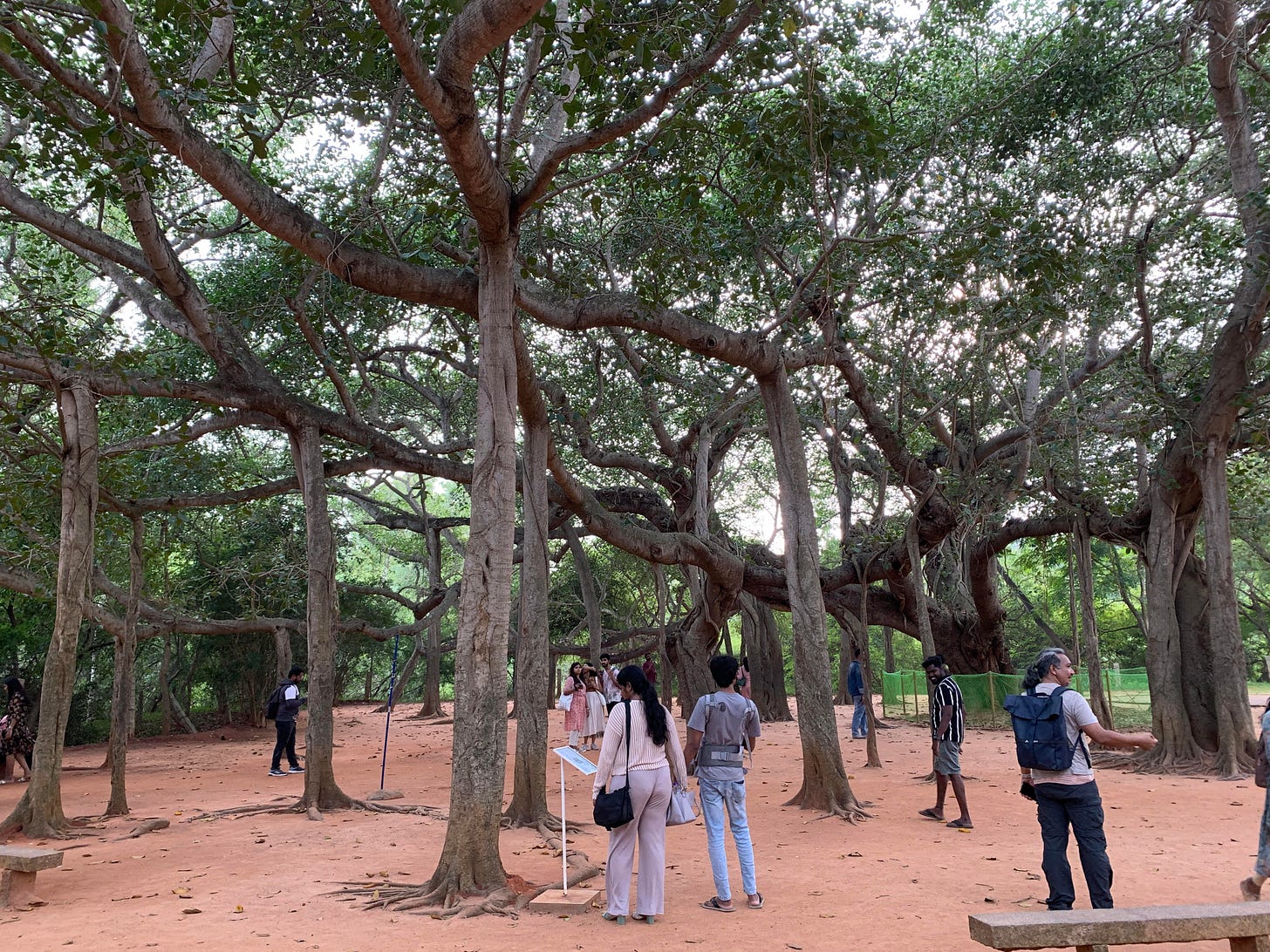
Past the magic banyan, a final walkway led to the viewing platform from which point the Matrimandir seemed to float above red sandstone foundations. I couldn’t help but think that this was India’s spiritual version of Spaceship Earth, the Buckminster Fuller-inspired centerpiece of Disney World’s EPCOT Center in Florida.

Though the last sentence may have verged on sacrilege, my Matrimandir experience did, in fact, kick off a theme park-like 48 hr period of intense inspiration that rattled my world in all the right ways.
Returning to the Tibet Pavillion we enjoyed daal, vegetable curry, and pompadums chatting happily about all the fruitful overlaps between Metta Gardening and Kok Nong Nha.
After dinner, a group reflection was organized in the main meditation hall where I had the honor of sharing a short introduction to kava and talanoa – the traditional drink and practice of relationality that I had been studying in Fiji for the past 9 months.
‘Bula!’ and synchronized claps echoed around the hall as each shell was shared with words of gratitude. The magic of the mix never fails and under the watchful eyes of Guru Rinpoche our talanoa was alive with the recognition of hardships endured and friendships reinforced.
The morning of our last full day in Auroville I woke early and went for a refreshing stroll through the greenery with my roommate P’Aum. A gifted Thai musician with a knack for creating ethereal soundscapes, Aum and I set off in search of a burial site we had heard mentioned the previous evening.
With only a vague sense of direction, we followed bucolic paths around the Matrimadir Peace Gardens glimpsing the glistening temple every few minutes through fog and mounds of excavated earth.
It was only on this semi-aimless adventure that the reality of Auroville began to dawn on me.
This was much less a town than a giant research facility with an endless array of weird laboratories exploring alternative modes of education, agriculture, construction, coordination, and community living.
I mean weird in the old English sense of ‘wyrd’ which originally meant fate or destiny. The diversity of folks that this experimental city had magnetized to follow the call to co-create a more beautiful and harmonious world is on a scale I think only possible in India – where simply taking a bus from point A to B can turn the world upside down.
After meandering past leafy guesthouses with names like Serendipity and Joy Community, Aum and I completed a full circle and immediately stumbled upon the megalithic burial site. There we found a few cairn circles surrounded by larger flats rock beneath which urns and treasures from very pre-Aurovillian times lay at rest.
Pondering what might be left of the Auroville experiment in another 2500 years we returned to the guest house ready for the day ahead.
Compressed Stabilized Reality
Just a 10-minute walk from the Tibetan Pavillion our group arrived at AuroYali, an earth architecture and natural construction unit of the Auroville Universal Town. Working to ‘build a new consciousness within the field of building construction’ AuroYali specializes in turnkey solutions for clients seeking ecological homes and structures built largely with Compressed Stabilized Earth Blocks (CSEB).
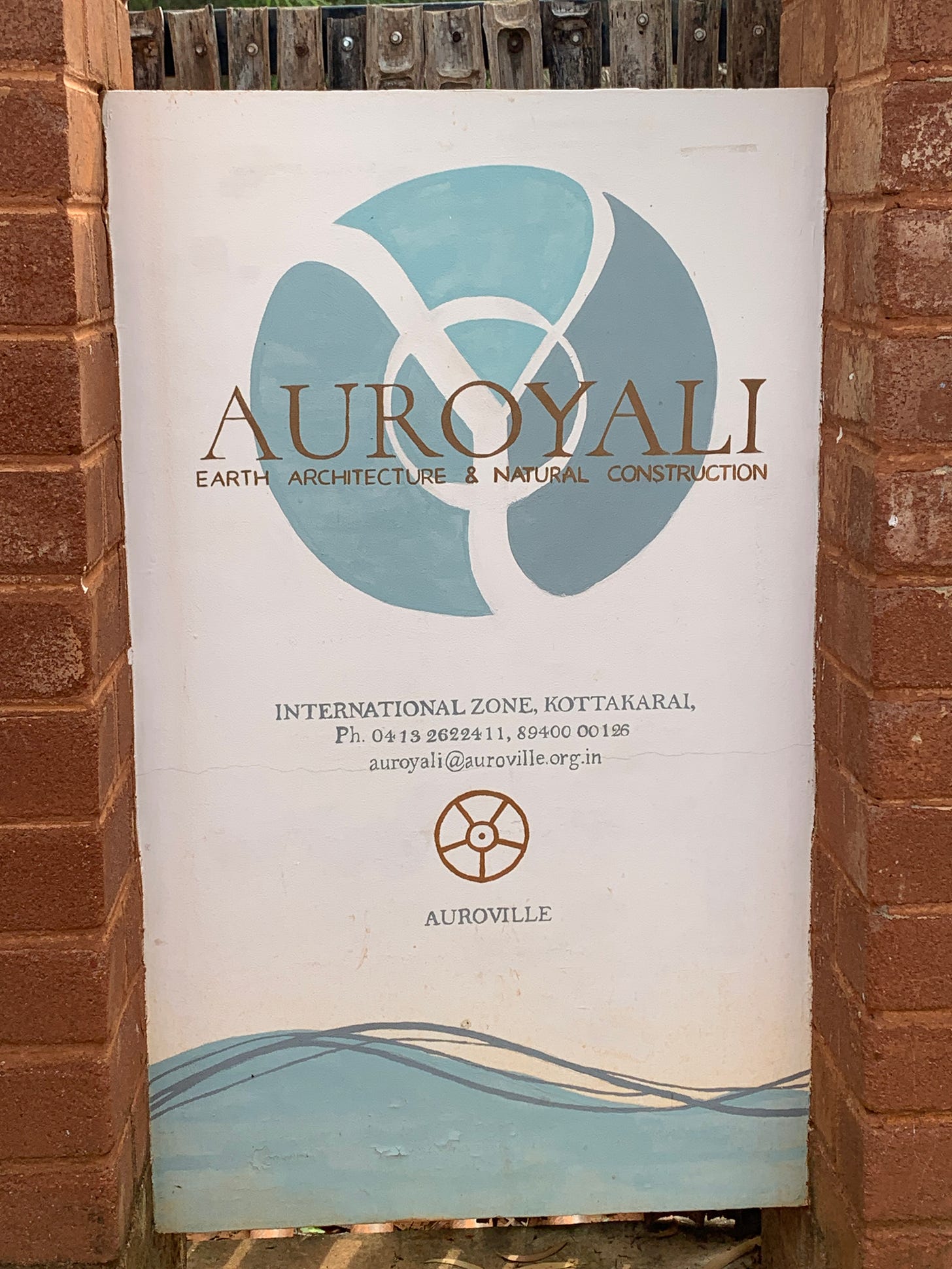
Our group facilitator Geetha walked us through the process of producing these unique earth blocks. Soil is first sieved through a machine to ensure consistency then moistened with water and mixed together with 5% cement (or lime if the soil has a lot of clay). The addition of a small amount of stabilizer significantly enhances the compressive strength and weather resistance of CSEB compared to traditional adobe mud bricks.
Utilizing these machines Geetha is coordinating an inspiring project under the auspices of the Chennai-based Foundation of His Sacred Majesty offering employment and vocational training for rural women in local villages. From brick-making to marketing this project provides an avenue for professional empowerment beyond constrictive domestic situations that many rural women in the area face.
The act of brick-making was a fantastic kinetic experience with the manual press machines. After loading the earth mixture into a small hopper the brick mold is filled and the long arm of the machine is pounded four or five times. With each thud, the earth is further compressed until a satisfying click releases the top part of the mold through which the finished bricks are popped after a few more leans on the arm.
The bricks are then set aside to cure in the open air for four weeks by which time the 5% cement stabilizer has hardened and construction can begin. With a beaming smile, AuroYali’s Executive Director Mohan Jayaraman explained the variety of applications possible with CSEB from load-bearing walls to round arches and Catalan vaults.
Many shapes beyond standard rectangular bricks can be pressed with the machines. Mohan illustrated this with photos of a recent AuroYali project completed in Bangalore employing CSEB tiles to create a massive timbrel vaulted connection between two office blocks where a restaurant was to be established.
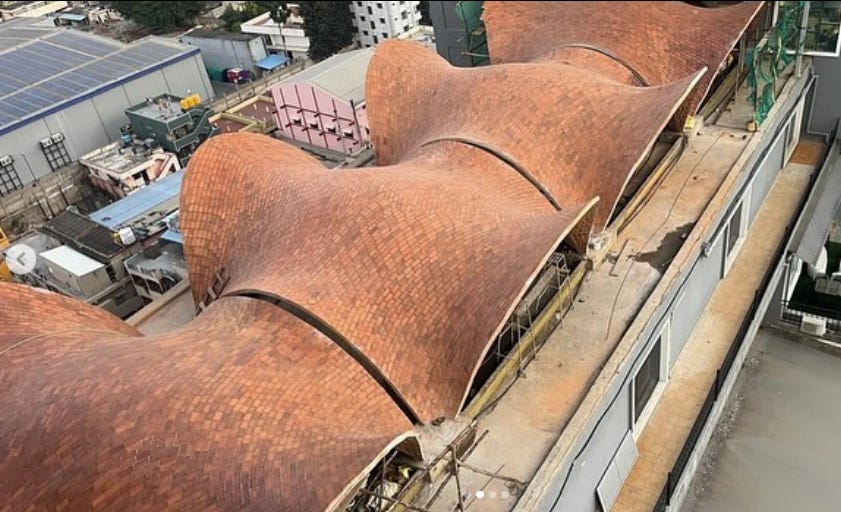
Before starting AuroYali Mohan had spent considerable time at Auroville’s Earth Insitute, a pioneering research and development laboratory and the Asia representative for the UN Chair of Earthen Architecture. After a hearty thanks to Mohan and his team our group paid a visit to the Institute a few quiet roads away.
The Auroville Earth Institute is credited with the popularization of CSEB and the invention of the Auram Press 3000, a block-making machine that can produce up to 70 different blocks with just 18 molds. Somewhat like LEGO for grownups, these blocks include hollow bricks that make for excellent insulation and specialty forms for utility fittings such as pipes and light switches.
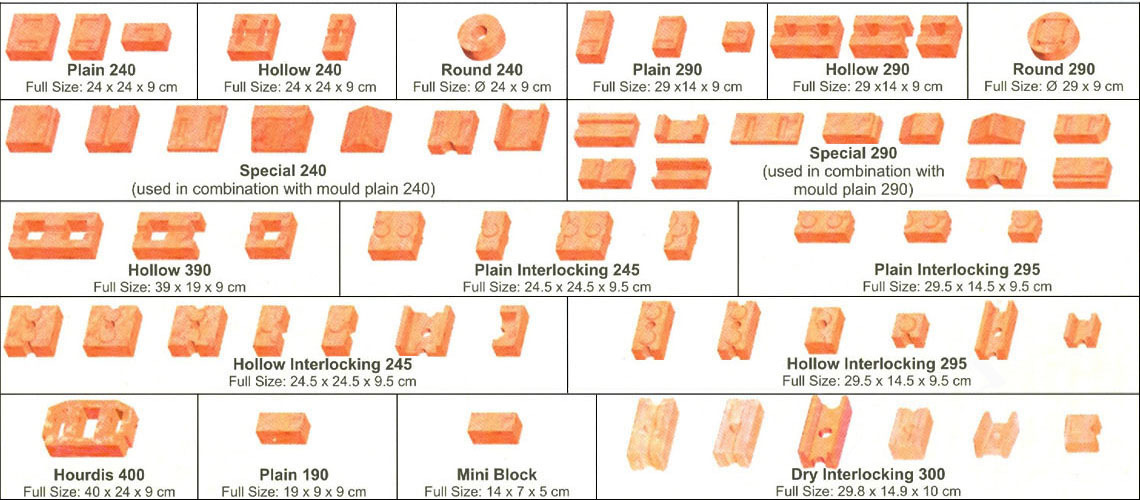
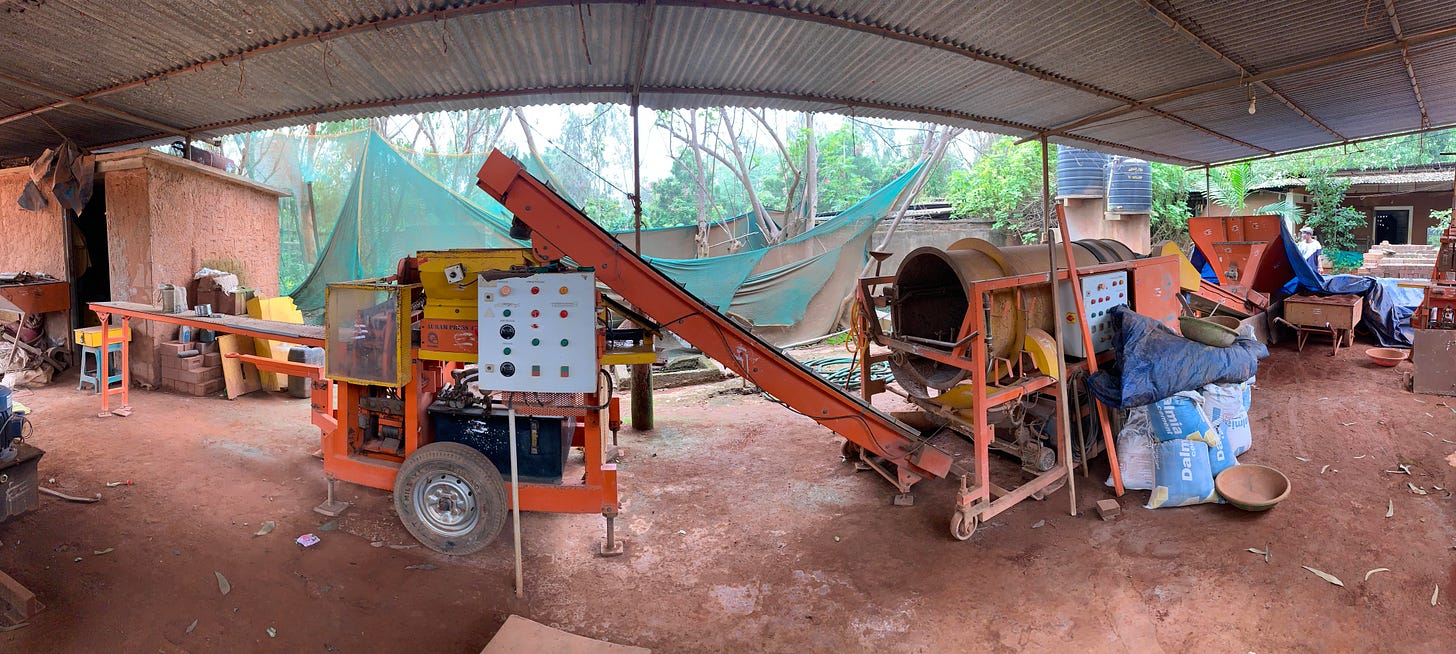
The Institute’s small showroom contained a world of information on Earthen Construction including a wall of soil samples from around the globe. Detailed histories of earth building from Yemen to South America were also presented along CSEB mythbusting and examples of the Institute’s ongoing research projects.
The buildings of the Institute itself felt like a mixture between Star Wars Tatooine habitations and a tropical marketplace bazzar. Sterling examples of high Egyptian vaults and arches of various kinds were on display achieved by tapering the wall thickness from base to apex, a technique tailored for CSEB at the Institute.
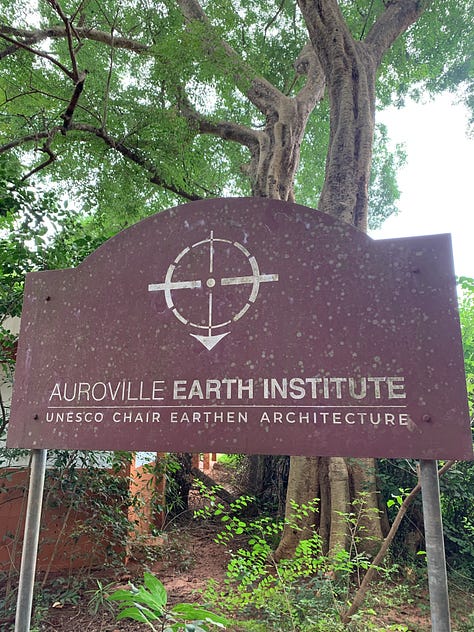
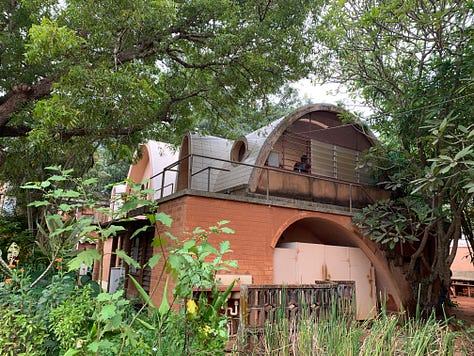
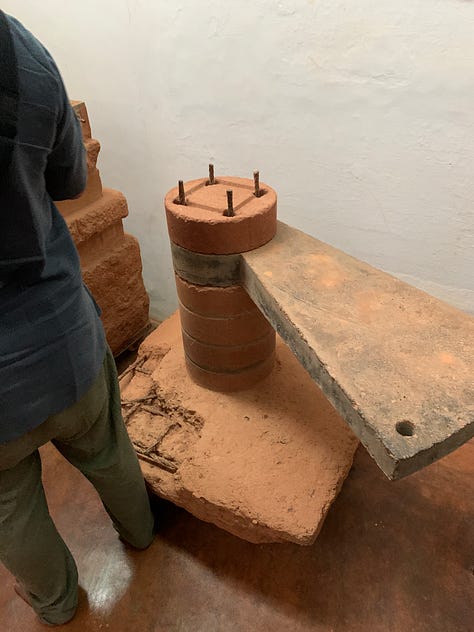


If the day could do anything more to inspire my passion for natural building I felt I may never leave. Yet it was only early afternoon and we were still set to visit the Auroville Bamboo Centre – the only place I had actually intended to visit prior to arrival.
Auroville Bamboo Center
Beneath light drizzle we walked through a vividly colored Hindu temple gatehouse into a quiet neighborhood avoiding cow paddies and puddles along the way. Winding back into denser forest it struck me how unassuming Auroville was.
In other countries I had seen similar eco-building outfits positioning themselves as boutique design studios with polished compounds, expensive showrooms and hefty service fees. Here these creative laboratories seem to unfold naturally from the landscape, less concerned with attracting attention than simply trusting that the right people would find them.
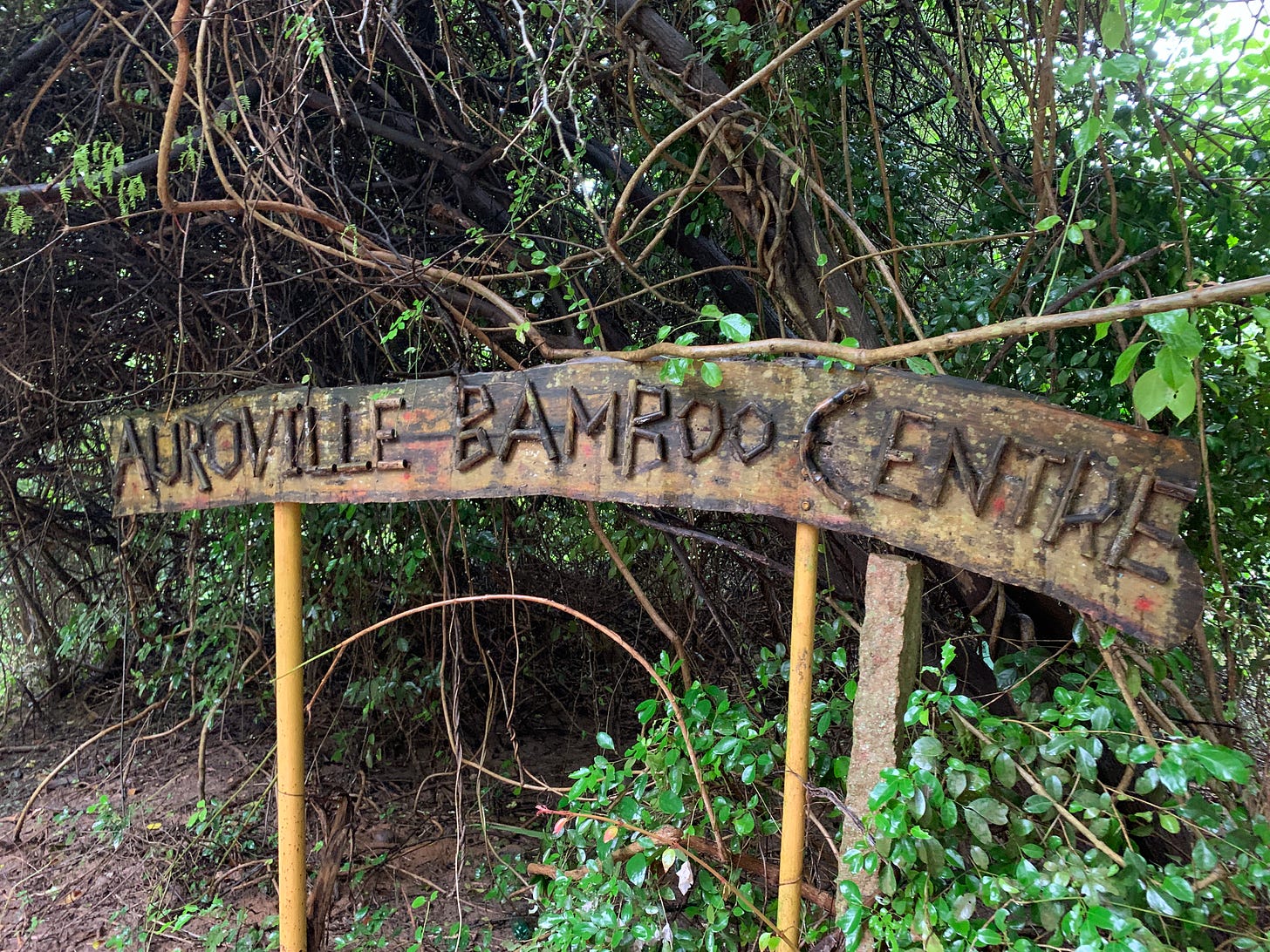
In terms of practicality the Auroville Bamboo Center, founded in 2009, exceeded my expectations. On a short guided tour, we were taken around the quiet campus observing collapsable bamboo yurts, hyperbolic roofs, and the main workshop space where a neat display of joinery solutions hung from the ceiling.
I was surprised to see the liberal use of coconut sinnet rope in binding bamboo together as this material is similarly used across the Fiji Islands (iTaukei. mugimugi) for traditional construction.
Behind the flowing roof of the shop building a little hamlet of bamboo houses stood, each the likely product of building workshops exploring different approaches to Shelter combining earth walls with bamboo frames. Humble in design yet pleasing to the eye, the handmade quality of these structures radiated ‘home’.
Though we didn’t linger long at the Bamboo Center our group did manage to bring the instrument gallery to life with raucous xylophonic activity and patronize the shop with much enthusiasm.

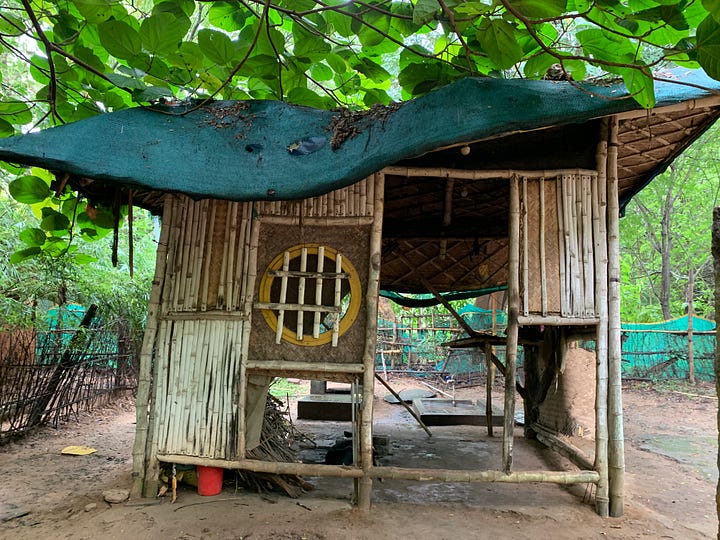
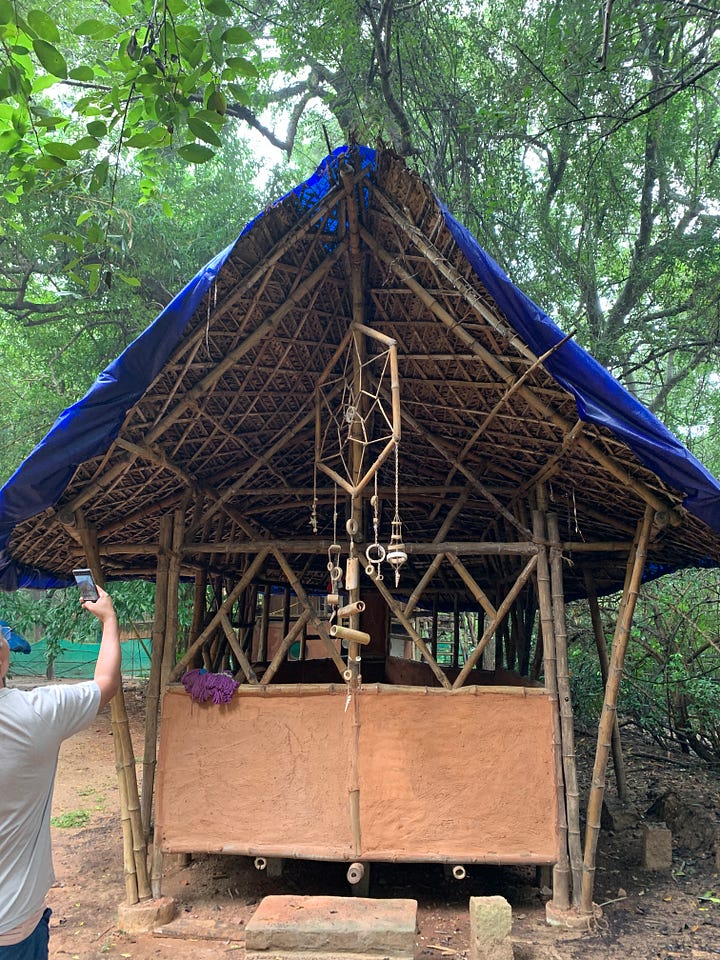
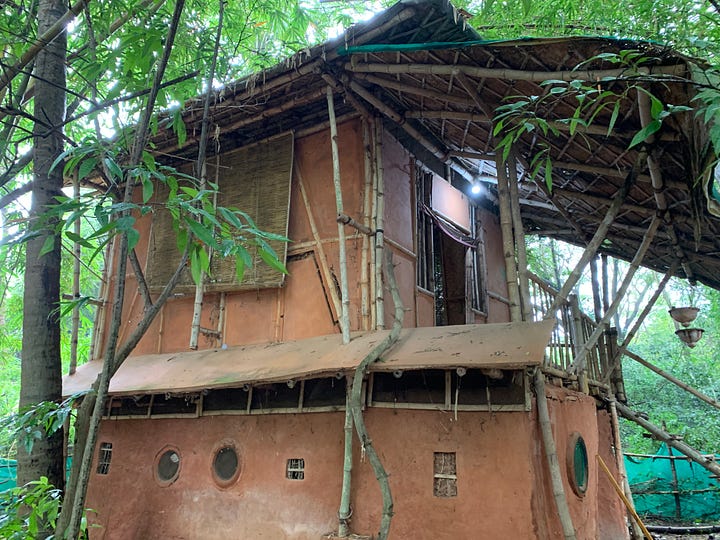
The last to leave, I walked slowly out of the Center and back down the quiet dirt road feeling somewhat dazed by the nutrition my soul had just received in such a short time.
It was regenerative to be surrounded again by people and places that not only resonate on similar creative wavelengths – but manifest their creativity into the physical world, continuing the inspiration game forever more.
Returning to Reality:
At the outset, I had only the faintest idea of what might lay between the mysterious stretch of country separating Pondicherry from Chennai.
Auroville’s aura turned out to be magnetic not because of an airy eco-vision but thanks to the vitality of our Eco-Temple group.
Living passions that were brought to life and warmly exchanged during our four days there. From planting seeds with loving kindness to sweaty engagement with groundwater restoration, eco-spirituality was practiced not preached.
My own heart, body, and mind were invigorated by the hands-on exposure to natural building practitioners, their earthen workspaces, and creations – finally tasting a world that I had only dreamed might exist in such an accessible and friendly environment.
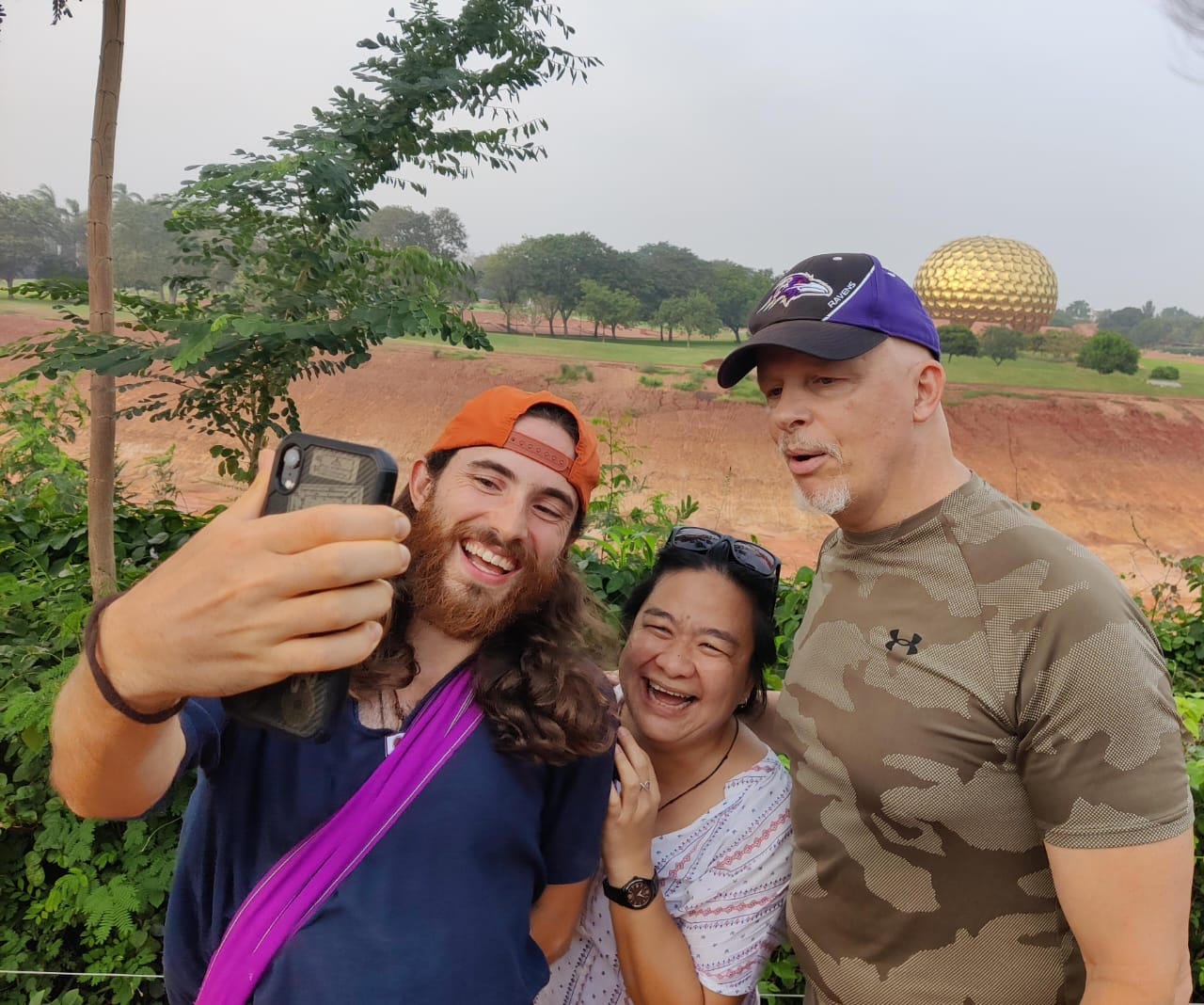
I will speak for myself in saying that the Community Development part of the Eco Temple Community Development Initiative worked. We bonded in the dirt and over tea, never seeming to finish conversations while making endless plans to follow up.
Over the following days of the full INEB conference, the group remained tightly knit, enjoying the opportunity to hear the stories of more friends sharing deeply about ongoing work in their home countries.
Sukhavati:
A final piece of the puzzle also came into clearer view during these integrative sessions in Chennai. The Sukhavati Eco-Temple Project with the Foundation of His Sacred Majesty had provided a somewhat illusive background to the Auroville exposures despite its prominence in our signage.
A multidimensional initiative to build a space for learning, empowerment, and appreciation of Tamil Buddhist culture – Gautham Prabhu, Founder of the Tamil Buddhist Society and Foundation of His Sacred Majesty, shared that Sukhavati is carefully positioning itself in Right Relationship with local communities, ecology and political structures.
While the temple has yet to take physical form, enduring efforts over the past 8 years from Gautham’s team have brought the Sukhavati dream to life in many hearts across the globe.
In truth, it is the mindful and diligent cultivation of these seeds that I believe is the Eco-Temple Community’s greatest strength. From Myanmar’s jungles to Tokyo’s urban sprawl, this dynamic group of eco-folk continues rallying against enormous odds to build a “Very Goooood!” reality for all beings.
As the physical and experiential seeds planted in Auroville have started settling into the soils of life and time, I carry the clear reminder that each of us has a part to play in nourishing this Great Eco Temple we all call home.
Thanks for reading Dexperimental 🙂 This a reader-supported publication, to receive new posts and support my work, please consider becoming a free or paid subscriber.

